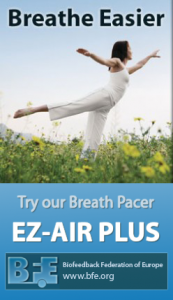Workshop – Drs. Lynda and Michael Thompson
We are offering two 1-day workshops with Drs. Lynda and Michael Thompson.
PAY ATTENTION! How Accurate Assessment Leads to Effective Intervention for Attention Deficit Hyperactivity Disorder (ADHD)
1-day Workshop – June 9, 2016
Instructors: Dr. Lynda Thompson & Dr. Michael Thompson
Participants will learn how to do an efficient and accurate assessment that leads to effective intervention for children, adolescents and adults who have symptoms of Attention-Deficit/Hyperactivity Disorder (ADHD), both the Inattentive presentation and the Combined (inattentive, hyperactive and impulsive) presentation. The intervention is multimodal and combines neurofeedback (NFB) with biofeedback, especially heart rate variability training (HRV). Clients can range from children who underachieve in school to executives and entrepreneurs who are successful but frustrated by never getting their paperwork done. Patients who have a diagnosis of ADHD symptoms can vary from children with a relatively simple difficulty with attention span to patients who have a complex array of other difficulties and co-morbidities, such as Learning Disabilities, Asperger’s Syndrome, Autism Spectrum Disorders, Affect Disorders, and movement disorders, including Tourette’s and Parkinson’s Disease. Assessment will therefore vary depending on the presenting symptoms.
We will share the successful approach developed at the ADD Centre & Biofeedback Institute of Toronto over the last 23 years. Assessments include history taking and information concerning the family, social functioning, school and/or work performance, medical factors (allergies, sleep apnea, head injuries, etc.) and extracurricular interests. There are also questionnaires and, for more objective test data, continuous performance tests (T.O.V.A. and IVA) and a single channel (Cz) EEG assessment. Psycho-educational testing. (IQ and academic measures) may be done during a second appointment if that information is needed. With more complex patients who may have comorbidity, testing can include some or all of the following: 19 channel quantitative electroencephalogram (QEEG), event related potentials (ERPs), heart rate variability (HRV), biofeedback variables measured during a stress assessment (heart rate, breathing rate , electrodermal response (EDR), electromyogram (EMG), skin temperature) and data collection using the eVox from EvokeNeuroscience that has self-ratings, a continuous performance test, quantitative EGG measures, ERP measurements, and heart rate variability measures. This testing is combined with questionnaires regarding ADHD symptoms, social-emotional functioning, and general health.
For ADHD this assessment can be accomplished in a half-day and that includes time for a practice training session. If the 19-channel data collection is needed then it becomes a full day assessment. The single channel QEEG assessment and interpretation will be demonstrated in this workshop.
Theoretical aspects of the presentation will review networks involved in determining salience, paying attention (vigilance) and in sustaining attention. There will also be a review of the scientific literature that supports the efficacy of neurofeedback for ADHD, which is now substantial. This presentation will review some of the neuroanatomical underpinnings regarding why, how, and with what effect, LORETA z-score NFB combined with HRV training can be used in selected patients who have ADHD symptoms and a comorbid disorder such as Asperger’s syndrome, learning disability, and / or an affect disorder.
Intervention goals include recruiting neuroplasticity to change networks involved in self-regulation of attention, emotions, and memory. Methods primarily involve neurofeedback and biofeedback (especially HRV training) and metacognitive strategies (learning how to learn). Multi-modal intervention with children also includes discussion of dietary interventions in order to optimize functioning. The theoretical aspects of this presentation will be enriched and supported by case examples. There will be time for questions and related areas can be covered, too, such as working with athletes who have ADHD, as requested by participants.
Objectives:
Participants will be able to:
1. Outline the contributions of different assessment measures to the prescription of treatment interventions.
2. State the most frequently used EEG parameters for improving attention span and concentration
3. Describe the rationale for increasing sensorimotor rhythm (SMR) and method for doing this in patients who are hyperactive and impulsive.
4. Outline the major neuroanatomical components of a salience network
5. Outline the major neuroanatomical components of an attention network
6. Explain how heart – brain connections link to symptoms
7. List and describe appropriate assessment tools.
Concussion Hits Hard: Accurate Assessment Leads to Effective Intervention For Post-concussion Syndrome
1-day Workshop – June 10, 2016
Instructors: Dr. Lynda Thompson & Dr. Michael Thompson
This workshop will describe both basic and advanced assessment and intervention procedures that help identify, and target for treatment, the relevant Brodmann area sites, connections, and neural networks in people who have suffered mild traumatic brain injuries (mTBI). Neurofeedback and biofeedback can offer an effective intervention even years post-injury.
Assessment of the patient who has suffered a concussion should be first carried out by a knowledgeable medical specialist. Unfortunately, standard medical assessments often fail to detect damage to connections among neurons (diffuse axonal injury) that underlies the symptoms that the patient is experiencing. CT scans often show no abnormality because they look at structure, not disrupted physiology. In addition, traditional rehabilitation that mainly involves rest may do little to remedy the cognitive, emotional, and social deficiencies that may persist after mTBI. This presentation will share methods used successfully at the ADD Centre for efficient and accurate assessment that leads to effective intervention.
For many years, before LORETA neurofeedback was available, the assessment comprised clinical interview, single and/or two channel quantitative electroencephalogram (QEEG), stress assessment, continuous performance tests, and neuropsychological testing. The stress assessments assessed biofeedback variables including heart rate (HR), breathing rate (BrR) , electrodermal response (EDR), electromyogram (EMG), and skin temperature. The assessment was followed by interventions that used one and two channel neurofeedback (NFB) combined with biofeedback (BFB). Case examples will be given that demonstrate the remarkable success achieved with this rather basic methodology. Possibly success was achieved because the central location(s) of the active electrode(s) was over the cingulate gyrus and thus it could influence the Salience, Attention, Executive, Affect and Default networks. Indeed, it has now been shown that heart rate variability (HRV) involving measures of respiration and heart rate, can be an accurate assessment tool and HRV training can be helpful for intervention. This approach is still valid for those who do not have access to 19-channel assessments.
More recently, the assessment procedures include 19-channel data analysed using NeuroGuide and LORETA, plus a second assessment using the eVox equipment from Evoke Neuroscience that does data collection for 19-channel QEEG plus LORETA source localization, event related potentials (ERPs), a continuous performance test, and heart rate variability (HRV), along with a standardized questionnaire. The interpretive report is received over the internet from Evoke Neuroscience within 24 to 48 hours. The client also does on-line neuropsychological testing. When designing treatment we augment this 19-channel assessment with single channel assessment at sites where we may wish to train using single channel neurofeedback. HRV measurements are additionally analyzed using CardioPro software from Thought Technology for internationally accepted statistics, such as SDNN and power measurements. How this assessment is carried out and how the information leads to the development of an intervention plan will be described.
Discussion of theoretical aspects of what occurs during and after a concussion will include a description of the biochemical changes at the synaptic junctions in the brain that underlie diffuse axonal injury (DAI). QEEG and event related potentials (ERP) can reveal the effects of damage elicited by this stretching and twisting of axons. This damage will affect brain speed as shown by ERP measures In addition, TBI will usually have a negative impact on the right and/or left insula which, in turn, can relate to the changes in heart rate variability and HRV measures will be described.
This presentation will review some of the literature on TBI and the connections to cardiac problems. It will also outline the neuroanatomical underpinnings regarding why, how, and with what effect, LORETA z-score NFB can be used in conjunction with some combination of HRV training, transcranial direct current stimulation (tDCS), and metacognitive strategies, in addition to dietary interventions, to bring a client to a higher level of functioning. The theoretical aspects of this presentation will be supported and enlivened by case examples.
Objectives:
Participants will be able to:
- State how heart–brain connections link to symptoms seen after a TBI.
- List the components of an assessment.
- State why LORETA is a useful assessment tool
- State why ERPs are useful in assessment and for following the progress of treatment.
- State why a stress assessment is helpful for the patient and how the results can be used to plan intervention
- Describe how one and two channel NFB is combined with HRV training to treat patients who present with post-concussion syndrome.
- Define what a Brodmann Area is and briefly describe the location and functions of BA 24, 25, 31 and also BA 39 & 40 in both the dominant and non-dominant hemispheres.
- Define the term fasciculus and describe the connections of the uncinate fasciculus and of the cingulum in broad general terms.
- State why LORETA z-score NFB combined with HRV may be the preferred intervention for some clients.
- Outline the neuroanatomical connections of the nucleus of the solitary tract to areas in the hindbrain, midbrain and forebrain that may be influenced by HRV training.
- Outline the link between a head injury and chan ges in cardiac functioning as measured by heart rate variability.
- Define diffuse axonal injury and list and describe the major biochemical changes that can occur at the synaptic junctions with DAI.
About Lynda Thompson, Ph.D.
 Lynda Thompson, Ph.D. is a Psychologist who has done teaching, clinical psychology, school psychology and owned learning centers. She became Executive Director of The ADD Centre in Toronto in 1993 after discovering the world of Neurofeedback and deciding to specialize in that intervention. Her doctoral dissertation (1979) dealt with hyperactive children treated with methylphenidate. She is co-author with William Sears of “The A.D.D. Book: New Understandings, New Approaches to Parenting Your Child”. Since beginning a centre for biofeedback she has published 9 book chapters, and 14 journal articles with an emphasis on ADHD, Asperger’s Syndrome, Seizure disorders and stress management. She takes an active part in the main organizations concerning biofeedback, is a past Board Member of both the International Society for Neurofeedback and Research (ISNR) and the Biofeedback Certification International Alliance (BCIA), and was Chair of the Education Committee and Treasurer of the Neurofeedback Division of the Association for Applied Psychophysiology and Biofeedback (AAPB). With her husband, Michael Thompson, M.D. she co-authored The Neurofeedback Book: An Introduction to Basic Concepts in Applied Psychophysiology (2003). They have been invited to teach about neurofeedback and biofeedback in 25 countries on five continents and present frequently at professional meetings in these fields.
Lynda Thompson, Ph.D. is a Psychologist who has done teaching, clinical psychology, school psychology and owned learning centers. She became Executive Director of The ADD Centre in Toronto in 1993 after discovering the world of Neurofeedback and deciding to specialize in that intervention. Her doctoral dissertation (1979) dealt with hyperactive children treated with methylphenidate. She is co-author with William Sears of “The A.D.D. Book: New Understandings, New Approaches to Parenting Your Child”. Since beginning a centre for biofeedback she has published 9 book chapters, and 14 journal articles with an emphasis on ADHD, Asperger’s Syndrome, Seizure disorders and stress management. She takes an active part in the main organizations concerning biofeedback, is a past Board Member of both the International Society for Neurofeedback and Research (ISNR) and the Biofeedback Certification International Alliance (BCIA), and was Chair of the Education Committee and Treasurer of the Neurofeedback Division of the Association for Applied Psychophysiology and Biofeedback (AAPB). With her husband, Michael Thompson, M.D. she co-authored The Neurofeedback Book: An Introduction to Basic Concepts in Applied Psychophysiology (2003). They have been invited to teach about neurofeedback and biofeedback in 25 countries on five continents and present frequently at professional meetings in these fields.
About Michael Thompson, M.D.
 Michael Thompson, M.D. devotes his time to the administration of the Biofeedback Institute of Toronto and teaching about neurofeedback plus biofeedback. When formerly practicing medicine he was Medical Director of London Psychiatric Hospital; Associate Professor and head of post-graduate education in Psychiatry, University of Western Ontario; examiner for the Royal College of Physicians (Canada) for 10 years and chairman of their examinations committee in psychiatry. Numerous professional publications include A Resident’s Guide to Psychiatric Education. While Associate Professor, University of Toronto, he was psychiatric consultant to The Hospital for Sick Children’s neurology department and director of a centre that specialized in treating pre-school children with autistic spectrum disorders. Recent work has included more than 120 professional presentations and workshops on 5 continents and in more than 25 countries focused on assessment and training using EEG and peripheral Biofeedback.
Michael Thompson, M.D. devotes his time to the administration of the Biofeedback Institute of Toronto and teaching about neurofeedback plus biofeedback. When formerly practicing medicine he was Medical Director of London Psychiatric Hospital; Associate Professor and head of post-graduate education in Psychiatry, University of Western Ontario; examiner for the Royal College of Physicians (Canada) for 10 years and chairman of their examinations committee in psychiatry. Numerous professional publications include A Resident’s Guide to Psychiatric Education. While Associate Professor, University of Toronto, he was psychiatric consultant to The Hospital for Sick Children’s neurology department and director of a centre that specialized in treating pre-school children with autistic spectrum disorders. Recent work has included more than 120 professional presentations and workshops on 5 continents and in more than 25 countries focused on assessment and training using EEG and peripheral Biofeedback.
Prior to doing Neurofeedback, Dr. Thompson had more than 20 peer reviewed journal publications, 7 professional textbook chapters, one book and more than 100 presentations with a major focus on training psychiatrists, child development, attention deficit, learning, autism, and handling neurological illnesses. Since beginning a centre for biofeedback he has published with Dr. Lynda Thompson, 5 book chapters, and 14 journal articles on ADHD, Asperger’s Syndrome, and stress management, as well as books including the basic textbook in the field, The Neurofeedback Book: An Introduction to Basic Concepts in Applied Psychophysiology.

